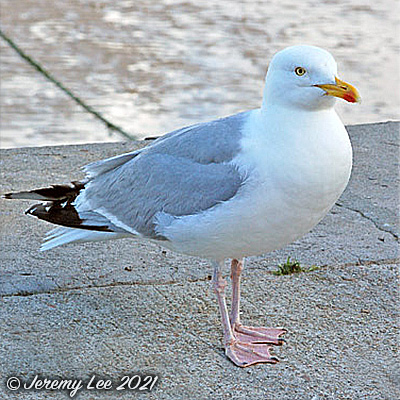
 |
|
Scientific Classifications explained » Amphibians » Ants » Aphids » Bees » Beetles » Birds » Bugs » Butterflies » Caterpillars » Damselflies » Dragonflies » Earwigs » Flies » Frog/Leafhoppers » Fungi » Galls » Grasshoppers » Harvestmen » Hoverflies » Lacewings » Ladybirds » Leaf Mines » Lichens » Mammals » Millipedes » Mosses » Moths » Sawflies » Slugs » Snails » Spiders » Trees » Wasps » Wild Flowers » Woodlice |
UK Nature > Birds > Larus argentatus

Scientific Name: Larus argentatus Common Name: Herring Gull Larus argentatus, more commonly known as the Herring Gull, is a large, noisy gull found throughout the year around our coasts and inland around rubbish tips, fields, large reservoirs and lakes, especially during winter. They are loud and competitive scavengers, happy to snatch another bird's meal. They spend much of their time perched near food sources, often in congregations of gulls. Adults have light grey backs, white under parts, and black wing tips with white 'mirrors'. Their legs are pink, with webbed feet and they have a orange-yellow, slightly hooked bill marked with a red spot. Young birds are mottled brown. They have suffered moderate declines over the past 25 years and over half of their breeding population in the UK is now confined to fewer than ten sites. |
|

https://www.uknature.co.uk is a website dedicated to showing the immense diversity of UK nature and wildlife. Our vast range of habitats, from lowland arable to snow covered mountains, from storm-ravaged coastlines to peaceful inland freshwater lakes and rivers, from dry, sandy heaths to deciduous and coniferous forests, all these habitats contribute to the abundance of UK nature. We have wild birds in huge numbers either residing or visiting our shores (597 recorded species as at July 2013) and we must also not forget the humble back garden with its grass lawns, flower beds filled with nectar rich flowers, shrubs and trees, all designed to attract huge numbers of insects such as bees, moths, butterflies and hoverflies; and finally the small ponds which provide safe havens for frogs, toads, newts and even slow worms and grass snakes. www.uknature.co.uk is the showcase for my personal passion, photographing uknature in all its glory. I sincerely hope you all enjoy the fruits of my labours. This site and all images contained therein is © Jeremy Lee 2004 - 2021. All Rights Reserved. Site design by Jeremy Lee. Site development & IT Support by Stuart Lee. |